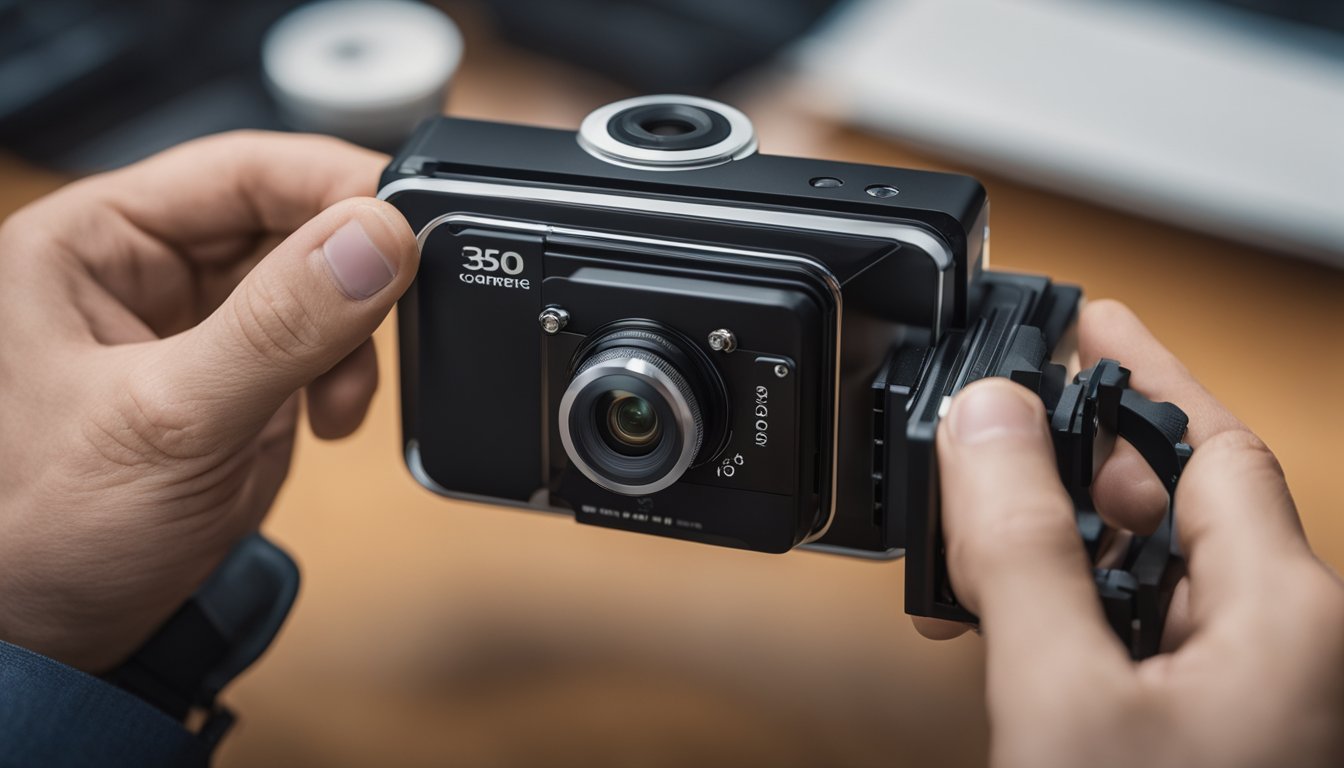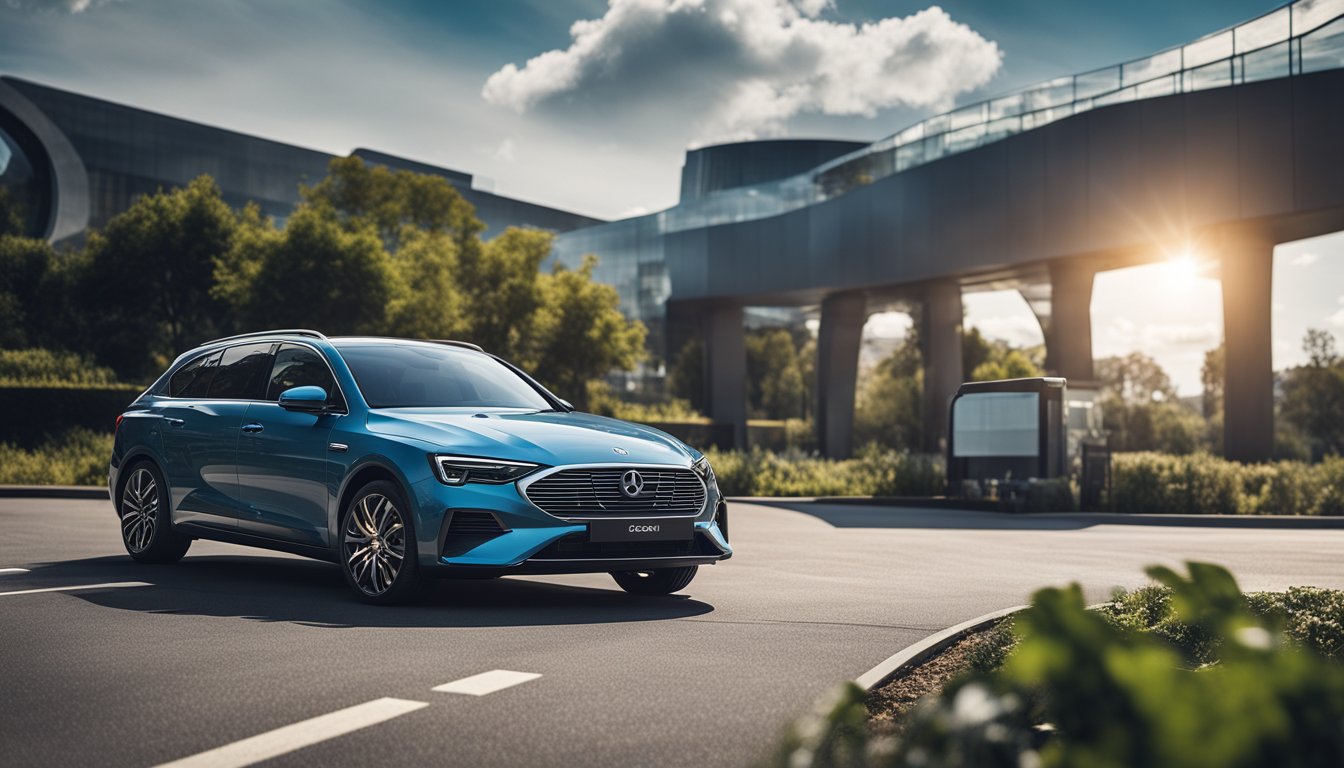Can You Retrofit a 360 Camera to Your Vehicle?

If you’re looking to upgrade your vehicle with a 360 camera system, you may be wondering if it’s possible to retrofit your existing vehicle with this technology. The answer is yes, it is possible to retrofit a 360 camera to your vehicle, but the process can be complex and costly. In this article, we’ll explore the ins and outs of retrofitting a 360 camera to your vehicle, including the benefits, challenges, and costs involved.
Understanding 360 Camera Systems
Before we delve into the retrofitting process, it’s important to understand what a 360 camera system is and how it works. A 360 camera system uses multiple cameras placed around the vehicle to provide a bird’s eye view of the surroundings. This can be especially helpful when parking or maneuvering in tight spaces. With a 360 camera system, you can see all around your vehicle, including blind spots, which can improve safety and reduce the risk of accidents. Now that we have an idea of what a 360 camera system is, let’s explore the retrofitting process and the factors to consider when assessing the compatibility of your vehicle.
Key Takeaways
- Retrofitting a 360 camera to your vehicle is possible, but it can be complex and costly.
- Before retrofitting, it’s important to assess your vehicle’s compatibility and select the right camera kit.
- Installation challenges and cost considerations are important factors to keep in mind when retrofitting a 360 camera system.
Understanding 360 Camera Systems
https://www.youtube.com/watch?v=xqWkJJOcU4g&embed=true
If you’re considering retrofitting a 360 camera system to your vehicle, it’s important to understand how these systems work and what components are involved. A 360-degree camera system is designed to provide drivers with a complete view of their vehicle’s surroundings, making it easier to park, navigate tight spaces, and avoid collisions.
Components of a 360-Degree Camera Setup
A typical 360-degree camera setup includes four cameras: one at the front, one at the rear, and one on each side of the vehicle. These cameras capture video footage of the vehicle’s surroundings, which is then stitched together to create a seamless, 360-degree view.
In addition to the cameras, a 360-degree camera system also requires a processing unit to handle the video data, as well as a display screen to show the driver the 360-degree view. Some systems also include sensors that can detect objects around the vehicle and provide warnings to the driver if they get too close.
How 360 Cameras Enhance Driving Safety
360-degree camera systems can greatly enhance driving safety, especially in situations where visibility is limited. For example, when parking in a tight space, a 360-degree camera system can show you exactly how close you are to other vehicles or obstacles, making it easier to avoid collisions.
In addition, a 360-degree camera system can provide a bird’s-eye view of the vehicle, allowing you to see not only what’s directly in front of you but also what’s behind and to the sides. This can be especially useful when navigating through crowded areas or backing up in a parking lot.
Overall, a 360-degree camera system can be a valuable addition to any vehicle, providing drivers with an extra layer of safety and convenience. While retrofitting a system to an existing vehicle can be expensive, it may be worth the investment for those who frequently drive in tight spaces or congested areas.
Assessing Your Vehicle for Retrofit Compatibility

If you’re considering retrofitting a 360 camera to your vehicle, the first step is to assess whether your vehicle is compatible with this type of retrofit. Here are a few things to keep in mind as you consider your options.
Checking VIN and Manufacturer Specifications
« Best 360 Camera with GPS: Capture Every Angle with Precision
Free Movies with 360 Camera: Experience Cinema Like Never Before! »
The first thing you should do is check your vehicle identification number (VIN) to see if your vehicle is compatible with a 360 camera retrofit. Some manufacturers offer retrofit kits that are specifically designed for certain vehicle models, so it’s important to make sure that your vehicle is compatible with the kit you’re considering.
You can also check your manufacturer’s specifications to see if they offer a retrofit kit for your vehicle. This information can usually be found on the manufacturer’s website or by contacting their customer service department.
Understanding the Role of Software and Firmware
Another important consideration when retrofitting a 360 camera to your vehicle is the role of software and firmware. In order for the camera to function properly, it needs to be integrated with your vehicle’s existing software and firmware.
This means that you’ll need to make sure that the retrofit kit you’re considering is compatible with your vehicle’s software and firmware. You may also need to update your vehicle’s software and firmware in order to ensure that the new camera functions properly.
It’s also important to note that some retrofit kits may require additional modules or components in order to function properly. Be sure to check the manufacturer’s specifications carefully to make sure that you have all of the necessary components before attempting to install the retrofit kit.
By keeping these considerations in mind, you can assess whether your vehicle is compatible with a 360 camera retrofit and choose a retrofit kit that will work well with your vehicle’s existing systems.
The Retrofit Process Explained

If your vehicle did not come with a 360 camera and you want to retrofit it, there are a few things you need to know. Retrofitting a 360 camera can be a complex process, but it is possible. Here is a step-by-step guide to retrofitting a 360 camera.
Step-by-Step Guide to Retrofitting a 360 Camera
Determine if your vehicle is compatible with a 360 camera retrofit. Check with your dealership or a trusted mechanic to see if your vehicle’s wiring and electrical system can handle a 360 camera retrofit.
Purchase a 360 camera retrofit kit. You can purchase a kit from your dealership or an aftermarket supplier. Make sure the kit is compatible with your vehicle’s make and model.
Install the cameras. The cameras should be installed on the front, rear, and sides of the vehicle. The kit should come with instructions on how to install the cameras.
Install the wiring harness. The wiring harness connects the cameras to the control module. The harness should be installed according to the kit’s instructions.
Install the control module. The control module processes the camera feeds and displays them on the vehicle’s display screen. The module should be installed according to the kit’s instructions.
Test the system. Once the cameras and control module are installed, test the system to make sure it is working properly. Make sure the cameras are displaying the correct image and that the system is responding to your inputs.
Electrical and Wiring Considerations
When retrofitting a 360 camera, you need to consider the electrical and wiring requirements of the system. The cameras and control module require power, and the wiring harness needs to be installed correctly to ensure proper operation of the system.
Make sure you follow the kit’s instructions carefully when installing the wiring harness. The harness should be installed in a way that does not interfere with other electrical systems in the vehicle. If you are not comfortable with electrical work, it is best to have a professional install the system for you.
In conclusion, retrofitting a 360 camera can be a complex process, but it is possible with the right kit and installation process. Make sure you follow the instructions carefully and test the system thoroughly before using it on the road.
Selecting the Right 360 Camera Kit
https://www.youtube.com/watch?v=5MvtlBYOFHg&embed=true
If you’re considering retrofitting a 360 camera to your car, you’ll need to select the right kit for your needs. Here are some things to consider when making your choice.
Aftermarket Kits vs. OEM Options
When it comes to retrofitting a 360 camera to your car, you have two options: aftermarket kits or OEM options. Aftermarket kits are typically less expensive than OEM options, but they may not be as reliable or compatible with your car’s existing systems. OEM options, on the other hand, are designed specifically for your car and are more likely to be reliable and compatible. However, they can be more expensive.
Evaluating Camera Quality and Compatibility
When selecting a 360 camera kit, it’s important to evaluate the camera quality and compatibility. Look for a kit that offers high-quality cameras that can capture clear, detailed images. You should also consider the compatibility of the kit with your car’s existing systems. Some kits may require additional modifications or upgrades to work properly with your car.
Another factor to consider is the price range of the kit. While aftermarket kits may be less expensive, they may not offer the same level of quality or compatibility as OEM options. On the other hand, OEM options can be more expensive, but they are designed specifically for your car and are more likely to be reliable and compatible.
In summary, selecting the right 360 camera kit for your car requires careful consideration of your needs and budget. Whether you choose an aftermarket kit or an OEM option, make sure to evaluate the camera quality and compatibility to ensure that you get the best results.
Installation Challenges and Solutions

Dealing with Common Retrofit Hurdles
Retrofitting a 360 camera to your vehicle can be a challenging process, especially if you decide to do it yourself. One of the most common hurdles that DIY installers face is the need to run wires from the camera to the display unit. This can be a time-consuming and frustrating task, especially if you’re not familiar with the wiring in your vehicle.
Another challenge that you may encounter when retrofitting a 360 camera is finding the right mounting location for the camera. You want to make sure that the camera is mounted securely and that it provides a clear view of your surroundings. This can be difficult if you’re not familiar with the layout of your vehicle or if you’re not sure which mounting location will provide the best view.
To overcome these hurdles, it’s important to do your research before you start the installation process. Make sure you have all the necessary tools and equipment, and familiarize yourself with the wiring and layout of your vehicle. You may also want to consider purchasing a retrofit kit that is specifically designed for your vehicle make and model. These kits often come with detailed instructions and all the necessary components for a successful installation.
When to Seek Professional Assistance
While retrofitting a 360 camera can be a DIY project, there are some instances where it may be best to seek professional assistance. If you’re not comfortable working with wiring or if you’re not familiar with the layout of your vehicle, it may be best to leave the installation to a professional.
Additionally, retrofitting a 360 camera can be a distraction if you’re not familiar with the process. It’s important to stay focused on the task at hand and to avoid any distractions that may lead to mistakes or accidents. If you’re not confident in your ability to complete the installation safely and efficiently, it’s best to seek professional assistance.
Overall, retrofitting a 360 camera can be a challenging but rewarding project. By doing your research, taking your time, and seeking professional assistance when necessary, you can successfully retrofit a 360 camera to your vehicle and enjoy the benefits of improved visibility and safety on the road.
Integration with Existing Vehicle Systems

When retrofitting a 360 camera to your vehicle, it’s important to consider how it will integrate with your existing vehicle systems. Here are some aspects to keep in mind:
Syncing with Infotainment and Navigation
If you have an infotainment screen in your vehicle, you’ll want to make sure that the 360 camera integrates smoothly with it. Some retrofit kits may require additional hardware or software to sync properly. It’s important to check the compatibility of the retrofit kit with your vehicle’s infotainment system before making a purchase.
Additionally, if your vehicle has navigation, you’ll want to ensure that the 360 camera doesn’t interfere with it. Some retrofit kits may require additional software updates to ensure that the camera doesn’t disrupt your navigation system.
Software Updates and OTA Capabilities
When considering a retrofit kit, you’ll want to check if it has software updates and over-the-air (OTA) capabilities. This will ensure that any bugs or glitches can be fixed remotely, without the need for additional hardware or software. OTA capabilities can also make it easier to update the camera’s software as new features become available.
It’s essential to keep your camera’s software up to date to ensure that it functions properly and that any security vulnerabilities are addressed. Some retrofit kits may require manual updates, while others may have automatic updates.
Overall, it’s important to consider how the 360 camera will integrate with your existing vehicle systems when retrofitting. Checking compatibility, syncing with infotainment and navigation, and ensuring software updates and OTA capabilities are all crucial factors to consider.
Cost Considerations for Retrofitting

If you’re considering retrofitting a 360 camera to your vehicle, there are a few cost considerations to keep in mind. Retrofitting a 360 camera can be a significant investment, so it’s important to budget for the equipment and installation costs.
Budgeting for Equipment and Installation
The cost of retrofitting a 360 camera will depend on the make and model of your vehicle, as well as the type of camera system you choose. Some camera systems require more extensive installation than others, which can impact the overall cost.
In general, you can expect to pay several thousand dollars for a quality 360 camera system and installation. This may seem expensive, but it’s important to remember that you’re investing in a valuable safety feature that can help prevent accidents and protect your vehicle.
When budgeting for your retrofit, it’s important to consider the long-term value of the investment.
Understanding Long-Term Value
While retrofitting a 360 camera can be a significant upfront cost, it can also provide long-term value. A 360 camera system can help prevent accidents and protect your vehicle, which can save you money on repairs and insurance costs in the long run.
Additionally, retrofitting a 360 camera can increase the resale value of your vehicle. Many buyers are willing to pay a premium for vehicles with advanced safety features like a 360 camera system.
When considering the long-term value of your retrofit, it’s important to factor in the potential cost savings and increased resale value. While the upfront cost may be significant, the long-term benefits can make it a worthwhile investment.
Overall, retrofitting a 360 camera is a significant investment, but it can provide valuable safety benefits and long-term value. By budgeting for the equipment and installation costs and considering the long-term benefits, you can make an informed decision about whether retrofitting a 360 camera is the right choice for you.
Vehicle-Specific Retrofit Guides

If you’re considering retrofitting a 360 camera to your vehicle, it’s important to note that the process can vary depending on the make and model of your car. Here are some vehicle-specific retrofit guides to help you get started.
Retrofitting 360 Cameras on Popular Models
Toyota
If you own a Toyota, you may be able to retrofit a 360 camera system onto your vehicle. According to Bronco6G, retrofitting a 360 camera and 12″ screen onto a base model can be expensive, but it may be possible with the right expertise.
Ford F150
If you own a Ford F150, retrofitting a 360 camera may be possible. According to F150 Forum, retrofitting an OEM 360 camera onto a 2023 XLT 302a Sport may be possible, but it’s important to check with a professional installer to determine feasibility.
Volvo
If you own a Volvo, retrofitting a 360 camera may be possible. According to BimmerTech, retrofitting a surround view camera system onto a Volvo can assist with parking and difficult traffic situations.
Audi
If you own an Audi, retrofitting a 360 camera may be possible. According to AudiWorld, retrofitting a 360 camera system onto a Q7 may be possible, but it’s important to check with a professional installer to determine feasibility.
BMW
If you own a BMW, retrofitting a 360 camera may be possible. According to BimmerPost, retrofitting a 3D surround view camera system onto a BMW can be done, but it may require replacing the entire rearview mirror module and switch at the central console.
Land Rover
If you own a Land Rover, retrofitting a 360 camera may be possible. According to Land Rover Forums, retrofitting a 360 camera system onto a 2018 RRS can be done, but it may require additional parts and expertise.
Remember, retrofitting a 360 camera onto your vehicle can be a complex process and may require professional installation. Be sure to do your research and consult with a professional before attempting any retrofitting projects.
Enhancing Parking and Maneuverability
https://www.youtube.com/watch?v=P1wARKIFFpU&embed=true
Are you tired of struggling to park your car in tight spaces or maneuvering around obstacles? Retrofitting a 360 camera system to your car can significantly enhance your parking and driving experience. With a 360 camera system, you can have a complete view of your surroundings, which can help you avoid accidents and park your car with ease.
Adding Parking Sensors and Cameras
One way to enhance your parking experience is by adding parking sensors and cameras. Front parking sensors can help you park your car in tight spaces by alerting you when you are too close to an obstacle. Rear parking sensors can help you reverse your car without hitting anything. Adding a bed camera can also help you see the area behind your truck bed, making it easier to park and maneuver.
Improving Visibility with Side and Bed Cameras
Side mirrors can only provide a limited view of your surroundings. Adding side cameras can give you a wider view of the road, making it easier to change lanes and avoid accidents. Bed cameras can also help you see the area behind your truck bed, making it easier to park and maneuver.
In addition to enhancing your parking and driving experience, retrofitting a 360 camera system to your car can also increase the resale value of your vehicle. With the added safety and convenience features, your car will be more appealing to potential buyers.
Overall, retrofitting a 360 camera system to your car can significantly enhance your parking and driving experience. Adding parking sensors and cameras can help you park your car with ease, while side and bed cameras can improve your visibility and maneuverability.
Maintaining and Updating Your Retrofit Camera

Congratulations on successfully retrofitting your vehicle with a 360 camera! Now that you have it installed, it’s important to maintain and update it regularly to ensure that it continues to function as intended. This section will provide you with some tips on how to maintain and update your retrofit camera.
Regular Maintenance Tips
To keep your retrofit camera in good working condition, there are a few things you can do on a regular basis:
Clean the camera lens: Over time, the camera lens can become dirty or smudged, which can affect the quality of the camera images. To clean the lens, use a soft, dry cloth and gently wipe away any dirt or smudges. Avoid using harsh chemicals or abrasive materials that could scratch the lens.
Check the camera wiring: Make sure that the camera wiring is properly secured and not damaged. If you notice any frayed wires or loose connections, have them repaired immediately.
Inspect the camera housing: Check the camera housing for any signs of damage or wear and tear. If you notice any cracks or other damage, have the housing replaced.
Upgrading Camera Firmware and Software
Just like any other electronic device, your retrofit camera may need occasional firmware and software updates to fix bugs and improve performance. Here are some tips for upgrading your camera firmware and software:
Check for OTA updates: Some retrofit cameras may have Over-The-Air (OTA) update capabilities, which means that updates can be downloaded and installed wirelessly. Check the camera manufacturer’s website or documentation to see if OTA updates are available for your camera.
Download updates from the manufacturer’s website: If OTA updates are not available, check the manufacturer’s website for any available firmware or software updates. Follow the instructions provided by the manufacturer to download and install the updates.
Back up your camera settings: Before installing any updates, make sure to back up your camera settings in case the update causes any issues. This will allow you to easily restore your camera settings to their previous state if needed.
Follow the manufacturer’s instructions: Always follow the manufacturer’s instructions when installing updates. Improper installation could cause the camera to malfunction or even become permanently damaged.
By following these maintenance and update tips, you can ensure that your retrofit camera continues to provide you with high-quality, 360-degree views of your surroundings.
Frequently Asked Questions
https://www.youtube.com/watch?v=vI4UFFZ-GKI&embed=true
What is the typical cost to install an aftermarket 360 camera in a vehicle?
The cost to install an aftermarket 360 camera in a vehicle can vary depending on the make and model of the car, as well as the quality of the camera and the complexity of the installation. According to some sources, the cost can range from $500 to $1,500. However, it is always best to get a quote from a professional installer to get an accurate estimate.
How do I find a professional to install a 360 camera in my car?
To find a professional to install a 360 camera in your car, you can search online for car audio and electronics shops in your area. You can also ask for recommendations from friends or family members who have had a 360 camera installed in their car. It is important to choose a reputable and experienced installer to ensure that the camera is installed correctly and functions properly.
What are the best 360-degree cameras available for cars in 2023?
There are several 360-degree cameras available for cars in 2023. Some of the best options include the Garmin Dash Cam Tandem, the Vantrue N4, and the Thinkware F200 Pro. These cameras offer high-quality video, wide-angle lenses, and other features such as GPS and Wi-Fi connectivity.
Is it possible to add a 360 camera to any model of car?
While it is possible to add a 360 camera to most models of cars, it may not be practical or cost-effective for some vehicles. Some cars may require significant modifications to the electrical system or bodywork to accommodate the camera. It is best to consult with a professional installer to determine if your car is compatible with a 360 camera.
What are the benefits of having a 360-degree camera system in a car?
A 360-degree camera system in a car can provide several benefits, including improved visibility and safety while driving. The camera can help drivers see blind spots and obstacles in all directions, making it easier to park and maneuver in tight spaces. Additionally, the camera can provide evidence in the event of an accident or theft.
Can the 2023 F150 be equipped with a 360 camera package after purchase?
Yes, it is possible to retrofit a 360 camera package onto a 2023 F150 after purchase. However, it is important to note that this may void the vehicle’s warranty and may require significant modifications to the electrical system and bodywork. It is best to consult with a professional installer to determine the feasibility and cost of adding a 360 camera to your F150.











